THE TRIAL OF THE CENTURY: THE MURDER OF STANFORD WHITE
The Novel Ragtime by E.L. Doctorow loosely follows, among other events, the infamous triangle of
Harry Thaw,
Evelyn Nesbit, and famed New York architect
Stanford White. Neither the encapsulation in the subsequent movie or the stage play really do the full story justice. Many analysts have agreed that this story
DID result in the true "Trial of the Century", even though it more or less
began the century. Hopefully this entry will help clarify some of the murky details.
Architect Stanford White circa 1900.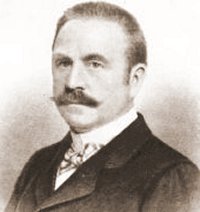 |
Evelyn Nesbit literally attracted attention from the time she was born with her stunning beauty. Shortly after her father died, she was able to turn that beauty into income in her early teens, posing for portrait artists and photographers to support her struggling family. It was this exposure that brought the young red-haired beauty to the attention of
Charles Dana Gibson, creator of the images of the much-vaunted
Gibson Girls, of which Evelyn soon joined the ranks. It was in Gibson's employ that Nesbit met
Stanford White, then at the height of his fame in Manhattan for designs such as the splendid Fifth Avenue mansions and his entertainment venue, Madison Square Garden, complete with a private apartment and a rooftop restaurant with a stage. White was known for his dalliances with young women, whom he adored, promoted, and took good care of. In 1902 when they met, Evelyn was quickly hustled into the show
Floradora appearing on White's Garden stage. She was soon invited to dine with White on multiple occasions, and he offered, as was his practice, to have his dentist fix a couple of bad teeth that allegedly marred her smile. Shortly thereafter White managed to lure Evelyn again to his private lair, filled her with alcohol, and then took full advantage of her while she was passed out. Her reaction to the event varies, depending on when it was told and to whom. She either reacted in horror or with acceptance. Just the same, she soon became White's sixteen-year-old mistress.
Evelyn Nesbit circa 1903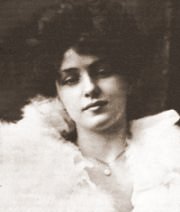 |
Already in the picture was one of many admirers of Nesbit's comeliness,
Harry K. Thaw "of Pittsburgh," as he was fond of announcing. He frequently sent flowers and gifts to Evelyn under the name of "Mr. Monroe." Evelyn had been warned about Thaw by her peers, but one evening they met at a dinner, and he exposed himself as her mysterious admirer. He then immediately tried to extract information from her on the relationship with "Stanny" (as she affectionately called him), a man that he had developed a livid hatred for. Thaw continued to pursue Nesbit despite warnings from White himself to stay away from the man. It was during this time that she developed another relationship with young
John Barrymore, eventual patriarch of a family of actors. Their relationship eventually resulted in a pregnancy and a subsequent stay in a school for girls where she eventually suffered from "appendicitis." Thaw tracked her to the institution and continued to woo and pursue her in spite of her condition. He eventually won the approval of Evelyn's mother and the matriarch of the school, Mrs. Demille, mother of noted director Cecil B. de Mille. After the delivery of her "appendix," White had Evelyn moved to a New York sanatorium where both he and Thaw managed to miss each other during frequent visits. She noticed that White's interest had waned, in part because she was no longer just his and also due to his roving nature. In 1904 Thaw managed to convince Evelyn and her mother that a trip to Paris would cure her ails.
Harry K. Thaw"of Pittsburgh."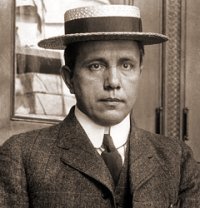 |
It was in Paris that Harry started proposing to Evelyn, a topic which she tried to avoid. When finally confronted on whether she was "pure," having believed the cover story about appendicitis, Evelyn spilled all the gory details about her relationship with White. Over the next few weeks Thaw became increasingly angry about the situation as he insisted that Evelyn repeatedly tell him all the details of her affair. After a falling out on the association with White, he sent Evelyn's mother back to the states and continued to travel in Europe alone (without a chaperone) with Evelyn, who now felt trapped in Thaw's control. It was during this time that she discovered that Thaw was addicted to both cocaine and morphine, a dependency which further distorted his perception of reality. Evelyn also suffered one or more beatings administered by Thaw. She eventually convinced him that they should return to New York. On her return she immediately sought out White who soon coaxed the story of Thaw's abuses and bizarre behavior out of her. He offered to give her legal help, but his attentions were obviously focused on other chorus girls by this time. On the other hand, Harry had increased his loving attention to Evelyn and resorted to begging to successfully win her back. This led to her second bout of "appendicitis" in 1905 and a second mysterious delivery of the organ.
A reflective Evelyn poses for a color picture postcard circa 1904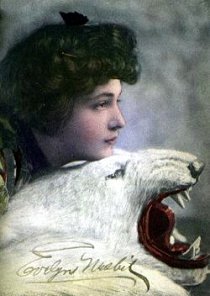 |
Directly after she left the hospital, Evelyn tried again to separate from the persistent Harry. It was his dominating mother that forcefully insisted to Nesbit that she and Harry should marry in an effort to stabilize his behavior. She complied with the request and moved to Pittsburgh where she became socially isolated and victim to her husband's shifting moods. Thaw was never convinced that his wife was over the relationship with White, and the rage he had about White's affair with his woman grew like a cancer. So he announced that they would be traveling again to Europe by way of New York. It was in Manhattan on June 25, 1906, that Harry Thaw walked into the rooftop restaurant at Madison Square Garden wearing a heavy black coat. As the performers on stage launched into
I Could Love A Million Girls and with Evelyn watching close by, Thaw walked up to White at a stage-side table and shot him three times in the face. He then removed the remaining bullets and held the gun up in the air, causing a panic in a crowd that initially thought the shooting was a prank. White was dead. Thaw was quickly put in custody. Evelyn was... it was hard to tell based on conflicting stories told at and after the trial. She was either relieved to be free of White, or mourning for his murder, or possibly both. In any case, it was possibly the lure of riches and the clearing of her name that led to her next act.
Thaw is led away from the courtroom during the "Trial of the Century."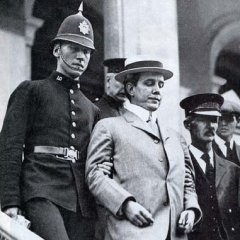 |
In advance of the trial, Harry's mother offered Evelyn one million dollars to stand by Harry and divorce him after the trial concluded. In spite of some resistance from pro-White factions, she played her role well and supported Harry on the stand, even though she often revealed unseemly details about his behaviors and their sexual escapades. The prosecution avoided Nesbit's role to the extent that they could, trying to keep focus on the errant murderer who had pled innocent due to insanity. However, the defense turned their part of the trial into a media circus of sorts, in spite of Evelyn's uneven performance on the stand where she both stood up for and humiliated her husband and his family all at once. The cross-examination caused some discomfort to Nesbit who offered varied and conflicting testimony to what she had previously said. However, public opinion shifted even more towards the victimized starlet, a factor that may have contributed to the jury deadlock of seven for and five against a conviction of first-degree murder. A second trial eventually rendered Thaw not guilty by reason of insanity, and he was sentenced to spend time in an asylum. Thaw soon escaped to Canada and was later recaptured, but public opinion in his favor eventually forced a ruling that found him sane and he was set free. Evelyn Nesbit-Thaw never saw her million dollars, and in spite of having given birth to Harry's son, never received any support of any kind from the father. She struggled for a living and was in and out of the public eye until her death in 1966. Harry Thaw continued to live as he had before, and passed away in 1947 with little fanfare.








 Loading Page. Please Wait...
Loading Page. Please Wait... 








